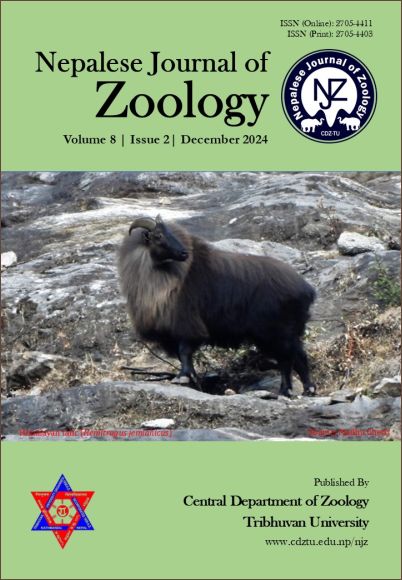Spatiotemporal variation in human-wildlife interactions: Evidence from forest edges of Khata Corridor, Bardia, western Nepal
DOI:
https://doi.org/10.3126/njz.v8i2.74930Keywords:
edge influence, fragmented landscape, Khata corridor, negative human-wildlife interactionAbstract
Extensive modification of natural forest habitat for economic and social requirements can put humans and animals in a juxtaposition, encouraging them to vie for the common resources, resulting in conflicts. Very little is known about the wildlife response in different categories of forest edges. We analyzed the relation between the different types of forest edges, viz. agriculture, grassland, river, human trail, and the type of negative human-wildlife interaction (NHWI) inflicted at the Khata Corridor of Bardia District, western Nepal. We collected the GPS position of NHWI incidents, conflicting animals, and the time of incidents, NHWI type, and edge type from field records, secondary literatures and interview of witnesses. We analyzed the distribution of NHWI incidents concerning different land-use types across forest edges. We observed a significant relationship between conflict animals and the type of edges, and NHWI types and conflict animals. Our observation showed significant species-specific interaction with forest edge types, where the elephant was mainly associated with agricultural damage, the leopard (Panthera pardus) with livestock predation, while the tiger's pattern of conflict was less in count but the cause for human injuries and livestock predation, and often linked to human settlement proximity. The temporal dimensions of NHWI showed elephants active mainly in the late evening until early morning hours, tigers in the late afternoon and nighttime, and leopards mostly at dusk until early morning. Agricultural forest edge was most susceptible towards NHWI. The negative human-leopard interaction was also higher in agriculture land, but proportionately higher in diverse edge type compared to other species. The analysis showed the highest density of NHWI in the areas with small forest patches and fragmented forests. We suggest forest landscapes to be managed maintaining intactness at the larger spatial extent to reduce NHWI, and support co-existence of wildlife and adjacent local communities.
Downloads
Downloads
Published
How to Cite
Issue
Section
License
Copyright (c) 2024 The Author(s)

This work is licensed under a Creative Commons Attribution-NonCommercial 4.0 International License.
This license enables reusers to distribute, remix, adapt, and build upon the material in any medium or format for noncommercial purposes only, and only so long as attribution is given to the creator.

